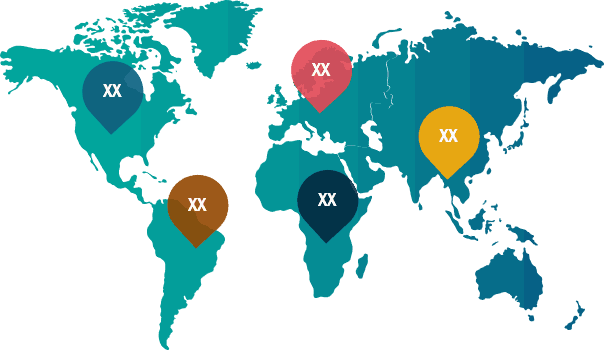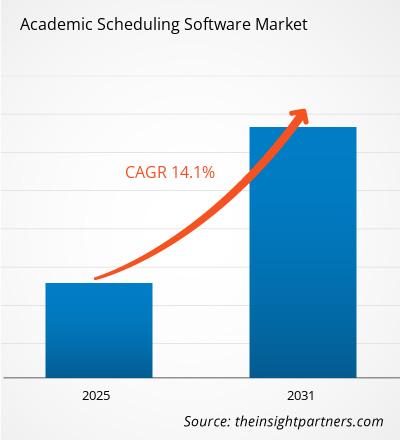学術スケジュール管理ソフトウェア市場は、2023~2031年の間に14.1%のCAGRを記録すると予想されています。AIを活用したスケジュール管理アルゴリズムとパーソナライズされた学生スケジュールは、今後も市場の主要なトレンドであり続けると思われます。
学術スケジュール管理ソフトウェア市場分析
- 学術スケジュール ソフトウェア市場には、学校、大学、短期大学などの教育機関におけるスケジュール プロセスの速度と効率を自動的に確保できるさまざまなソフトウェア製品が含まれます。
- 推進要因としては、学術学習アプリの需要増加、AIやMLなどの先進技術の導入増加、インターネットへのアクセス性などが挙げられます。
- このソフトウェアは、学校、大学、短期大学などの教育機関で広く使用されています。学術ソフトウェア市場のトレンドには、高度な技術とクラウドベースのソリューションの使用があります。
学術スケジュール管理ソフトウェア市場の概要
- 学術スケジュール ソフトウェアは、一般的に大学や学校で、スタッフや学生が毎日、毎週、毎月、学期ごと、または年間全体のタイムテーブルを計画できる学術カレンダーや日記をスケジュールするために使用されます。
- 高度なデジタル化の急増により、学術学習ソフトウェア市場の数は増加するでしょう。
- 学術スケジュール ソフトウェアは、さらにラテン アメリカ、北米、ヨーロッパ、アジア太平洋、中東、アフリカの 5 つの地理的地域に細分化されています。学術スケジュール ソフトウェア市場は主に、先進技術とデジタル化をリードする北米地域によって支配されています。
- 学術スケジュール ソフトウェアで重要な役割を果たしている主な企業としては、Applied software consultants、CollegeNET、College scheduler、ASIMUT software APS、FamilyID などがあります。
要件に合わせて調査をカスタマイズ
弊社の標準サービスでは対応できない分析と範囲を最適化し、カスタマイズすることができます。この柔軟性により、ビジネス計画と意思決定に必要な正確な情報を得ることができます。
学術スケジュール管理ソフトウェア市場:戦略的洞察

CAGR (2023 - 2031)14.1%- 市場規模 2023年
XX百万米ドル - 市場規模 2031年
XX百万米ドル

市場の動向
- 学術プログラムの複雑化、リソースの最適化の必要性
- クラウドベースのソリューション
- AIを活用したスケジュールアルゴリズム、パーソナライズされた生徒のスケジュール
主要人物
- 応用ソフトウェアコンサルタント
- ASIMUT ソフトウェア ApS
- 大学スケジュール
- カレッジネット
- 運転免許教育ソリューション
- EMSソフトウェア
- ファミリーID
- フォラディアン・テクノロジーズ
- サファイアソフトウェア
地域概要

- 北米
- ヨーロッパ
- アジア太平洋
- 南米と中央アメリカ
- 中東およびアフリカ
市場セグメンテーション
 製品タイプ
製品タイプ- クラウドベースとウェブベース
 エンドユーザー業界
エンドユーザー業界- 学校
- 大学
- 大学および教育機関
- サンプル PDF では、定性的および定量的な分析により、コンテンツの構造と情報の性質が紹介されています。
学術スケジュール管理ソフトウェア市場の推進要因と機会
市場を優先する学術プログラムの複雑化
- 今日の大学では、一般的に、より幅広いコース、専攻、専門分野を提供しています。これらのコースの組み合わせには前提条件や依存関係がある場合があり、この多様性によりスケジュールの調整が難しくなります。
- さらに、複数の学部、さらには複数の学科のコースをプログラムに含めることが一般的になっています。このようなプログラムでは、時間割について複数の講師間で調整する必要があります。
- 多くのプログラムには、講義、セミナー、ラボ、オンライン コンポーネントなどが組み合わされており、それぞれに独自のスケジュール設定が必要です。全体として、コースの依存関係と多数のプログラム要件により、学生が学習を完了できるように計画的なスケジュール設定が必要になります。
クラウドベースのソリューション
- クラウドベースであるため、ユーザーはインターネットに接続された任意のコンピューターまたはデバイスからスケジュール ソフトウェアにアクセスでき、管理者、教員、学生は遠隔地からスケジュールを表示および編集できます。
- クラウド ソリューションを利用することで、教育機関は、増加する入学者数 (学生数の増加) やコース提供数 (クラス数の増加) に応じて規模を拡大することができ、増加する人口に合わせてソフトウェアを継続的に実行するために大規模なハードウェア投資を行う必要がなくなります。
- 多くのスケジューリングシステムでは、コンピューティング ハードウェアとソフトウェアのライセンスを取得するために高額な初期費用がかかりますが、サブスクリプション ベースの価格設定モデルにより、その費用を時間の経過とともに分散させることができます。
学術スケジュール管理ソフトウェア市場レポートのセグメンテーション分析
学術スケジュール ソフトウェア市場分析の導出に貢献した主要なセグメントは、タイプとエンド ユーザー業界です。
- 製品タイプに基づいて、学術スケジュール ソフトウェア市場はクラウドベースと Web ベースに分けられます。
- エンドユーザー業界に基づいて、学術スケジュール ソフトウェア市場は、学校、大学、総合大学、教育機関に分かれています。
学術スケジュール管理ソフトウェアの地域別市場シェア分析
- 学術スケジュール管理ソフトウェア市場レポートは、北米、ヨーロッパ、アジア太平洋 (APAC)、中東およびアフリカ (MEA)、南米および中米を網羅する 5 つの主要地理的地域の詳細な分析で構成されており、現在の市場規模と過去の市場規模、2021 年から 2031 年までの予測が含まれています。
- 各地域はさらにそれぞれの国に細分化されています。このレポートは、地域レベルで市場に影響を与える推進要因、傾向、機会など、学術スケジュール ソフトウェア市場の動向を網羅し、18 か国以上の分析と予測を提供します。
- また、レポートでは、これらの地域の学術スケジュール ソフトウェア市場に影響を与える主要な要因の調査を含む PEST 分析も取り上げています。
学術スケジュール管理ソフトウェア市場レポートの範囲
| レポート属性 | 詳細 |
|---|---|
| 2023年の市場規模 | XX百万米ドル |
| 2031年までの市場規模 | XX百万米ドル |
| 世界のCAGR(2023年~2031年) | 14.1% |
| 履歴データ | 2021-2022 |
| 予測期間 | 2024-2031 |
| 対象セグメント | 製品タイプ別
|
| 対象地域と国 | 北米
|
| 市場リーダーと主要企業プロフィール |
|
- サンプル PDF では、定性的および定量的な分析により、コンテンツの構造と情報の性質が紹介されています。
学術スケジュール管理ソフトウェア市場のニュースと最近の動向
学術スケジュール ソフトウェア市場は、主要な企業出版物、協会データ、データベースなど、一次および二次調査後の定性的および定量的データを収集することによって評価されます。学術スケジュール ソフトウェア市場におけるいくつかの開発を以下に示します。
- CollegeNET, Inc. は本日、同社の 25Live ルームおよびイベント スケジューリング システムが CourseLeaf のセクション スケジューラ (CLSS) と統合されたことを発表しました。これにより、両社のパートナーシップが拡大し、高等教育機関のクライアントのスケジューリング機能が向上します。(出典: CollegeNET, Inc.、プレス リリース、2021 年 1 月)
学術スケジュール管理ソフトウェア市場レポートの対象範囲と成果物
「学術スケジューリングソフトウェア市場の規模と予測(2021〜2031年)」レポートでは、以下の分野をカバーする市場の詳細な分析を提供しています。
- 学術スケジュールソフトウェア市場の規模と予測、およびスコープに含まれるすべての主要な市場セグメントの世界、地域、国レベルでの予測
- 学術スケジュール管理ソフトウェア市場の動向と、推進要因、制約、主要な機会などの市場動向
- 詳細なPEST/ポーターの5つの力とSWOT分析
- 主要な市場動向、世界および、主要プレーヤー、規制、最近の市場動向を網羅した学術スケジュールソフトウェア市場分析
- 学術スケジュールソフトウェア市場の市場集中、ヒートマップ分析、主要プレーヤー、最近の動向を網羅した業界の状況と競争分析
- 詳細な企業プロフィール
- 過去2年間の分析、基準年、CAGRによる予測(7年間)
- PEST分析とSWOT分析
- 市場規模価値/数量 - 世界、地域、国
- 業界と競争環境
- Excel データセット



Report Coverage
Revenue forecast, Company Analysis, Industry landscape, Growth factors, and Trends

Segment Covered
This text is related
to segments covered.

Regional Scope
North America, Europe, Asia Pacific, Middle East & Africa, South & Central America

Country Scope
This text is related
to country scope.
よくある質問
Some of the customization options available based on request are additional 3–5 company profiles and country-specific analysis of 3–5 countries of your choice. Customizations are to be requested/discussed before making final order confirmation, as our team would review the same and check the feasibility.
The report can be delivered in PDF/PPT format; we can also share excel dataset based on the request.
The leading players operating in the Academic Scheduling Software market are Applied Software Consultants, ASIMUT software ApS, College Scheduler, CollegeNET, Drivers Ed Solutions, EMS Software, FamilyID, Foradian Technologies, and Sapphire Software.
AI-powered scheduling algorithms and personalized student schedules are likely to remain key trends in the market.
The global Academic Scheduling Software market is expected to grow at a CAGR of 14.1% during the forecast period 2023 - 2031.
The increasing complexity of academic programs and the need for resource optimization are expected to drive the academic scheduling software market.
Trends and growth analysis reports related to Technology, Media and Telecommunications : READ MORE..
The List of Companies
1. Applied Software Consultants
2. ASIMUT software ApS
3. College Scheduler
4. CollegeNET
5. Drivers Ed Solutions
6. EMS Software
7. FamilyID
8. Foradian Technologies
9. Sapphire Software
10. Schilling Consulting
11. Scholastico.com
The Insight Partners performs research in 4 major stages: Data Collection & Secondary Research, Primary Research, Data Analysis and Data Triangulation & Final Review.
- Data Collection and Secondary Research:
As a market research and consulting firm operating from a decade, we have published and advised several client across the globe. First step for any study will start with an assessment of currently available data and insights from existing reports. Further, historical and current market information is collected from Investor Presentations, Annual Reports, SEC Filings, etc., and other information related to company’s performance and market positioning are gathered from Paid Databases (Factiva, Hoovers, and Reuters) and various other publications available in public domain.
Several associations trade associates, technical forums, institutes, societies and organization are accessed to gain technical as well as market related insights through their publications such as research papers, blogs and press releases related to the studies are referred to get cues about the market. Further, white papers, journals, magazines, and other news articles published in last 3 years are scrutinized and analyzed to understand the current market trends.
- Primary Research:
The primarily interview analysis comprise of data obtained from industry participants interview and answers to survey questions gathered by in-house primary team.
For primary research, interviews are conducted with industry experts/CEOs/Marketing Managers/VPs/Subject Matter Experts from both demand and supply side to get a 360-degree view of the market. The primary team conducts several interviews based on the complexity of the markets to understand the various market trends and dynamics which makes research more credible and precise.
A typical research interview fulfils the following functions:
- Provides first-hand information on the market size, market trends, growth trends, competitive landscape, and outlook
- Validates and strengthens in-house secondary research findings
- Develops the analysis team’s expertise and market understanding
Primary research involves email interactions and telephone interviews for each market, category, segment, and sub-segment across geographies. The participants who typically take part in such a process include, but are not limited to:
- Industry participants: VPs, business development managers, market intelligence managers and national sales managers
- Outside experts: Valuation experts, research analysts and key opinion leaders specializing in the electronics and semiconductor industry.
Below is the breakup of our primary respondents by company, designation, and region:

Once we receive the confirmation from primary research sources or primary respondents, we finalize the base year market estimation and forecast the data as per the macroeconomic and microeconomic factors assessed during data collection.
- Data Analysis:
Once data is validated through both secondary as well as primary respondents, we finalize the market estimations by hypothesis formulation and factor analysis at regional and country level.
- Macro-Economic Factor Analysis:
We analyse macroeconomic indicators such the gross domestic product (GDP), increase in the demand for goods and services across industries, technological advancement, regional economic growth, governmental policies, the influence of COVID-19, PEST analysis, and other aspects. This analysis aids in setting benchmarks for various nations/regions and approximating market splits. Additionally, the general trend of the aforementioned components aid in determining the market's development possibilities.
- Country Level Data:
Various factors that are especially aligned to the country are taken into account to determine the market size for a certain area and country, including the presence of vendors, such as headquarters and offices, the country's GDP, demand patterns, and industry growth. To comprehend the market dynamics for the nation, a number of growth variables, inhibitors, application areas, and current market trends are researched. The aforementioned elements aid in determining the country's overall market's growth potential.
- Company Profile:
The “Table of Contents” is formulated by listing and analyzing more than 25 - 30 companies operating in the market ecosystem across geographies. However, we profile only 10 companies as a standard practice in our syndicate reports. These 10 companies comprise leading, emerging, and regional players. Nonetheless, our analysis is not restricted to the 10 listed companies, we also analyze other companies present in the market to develop a holistic view and understand the prevailing trends. The “Company Profiles” section in the report covers key facts, business description, products & services, financial information, SWOT analysis, and key developments. The financial information presented is extracted from the annual reports and official documents of the publicly listed companies. Upon collecting the information for the sections of respective companies, we verify them via various primary sources and then compile the data in respective company profiles. The company level information helps us in deriving the base number as well as in forecasting the market size.
- Developing Base Number:
Aggregation of sales statistics (2020-2022) and macro-economic factor, and other secondary and primary research insights are utilized to arrive at base number and related market shares for 2022. The data gaps are identified in this step and relevant market data is analyzed, collected from paid primary interviews or databases. On finalizing the base year market size, forecasts are developed on the basis of macro-economic, industry and market growth factors and company level analysis.
- Data Triangulation and Final Review:
The market findings and base year market size calculations are validated from supply as well as demand side. Demand side validations are based on macro-economic factor analysis and benchmarks for respective regions and countries. In case of supply side validations, revenues of major companies are estimated (in case not available) based on industry benchmark, approximate number of employees, product portfolio, and primary interviews revenues are gathered. Further revenue from target product/service segment is assessed to avoid overshooting of market statistics. In case of heavy deviations between supply and demand side values, all thes steps are repeated to achieve synchronization.
We follow an iterative model, wherein we share our research findings with Subject Matter Experts (SME’s) and Key Opinion Leaders (KOLs) until consensus view of the market is not formulated – this model negates any drastic deviation in the opinions of experts. Only validated and universally acceptable research findings are quoted in our reports.
We have important check points that we use to validate our research findings – which we call – data triangulation, where we validate the information, we generate from secondary sources with primary interviews and then we re-validate with our internal data bases and Subject matter experts. This comprehensive model enables us to deliver high quality, reliable data in shortest possible time.

 このレポートの無料サンプルを入手する
このレポートの無料サンプルを入手する